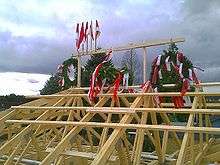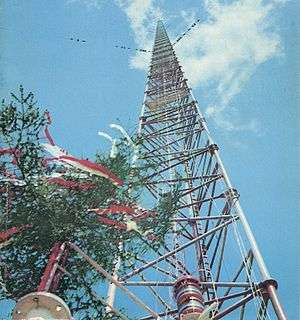Topping out

In building construction, topping out (sometimes referred to as topping off) is a builders' rite traditionally held when the last beam (or its equivalent) is placed atop a structure during its construction.
Nowadays the ceremony is often parlayed into a media event for public relations purposes.[1]
History
The practice of "topping out" a new building can be traced to the ancient Scandinavian religious rite of placing a tree atop a new building to appease the tree-dwelling spirits displaced in its construction.[2] Long an important component of timber frame building,[3] it migrated initially to England and Northern Europe, thence to the Americas.
A tree or leafy branch is placed on the topmost wood or iron beam, often with flags and streamers tied to it. A toast is usually drunk and sometimes workers are treated to a meal. In masonry construction the rite celebrates the bedding of the last block or brick.
In some cases a topping out event is held at an intermediate point, such as when the roof is dried in.[4]
The practice remains common in the United Kingdom, and assorted Commonwealth countries such as Australia [5] and Canada [6] as well as Germany, Austria, Iceland, Czech Republic, Slovakia, Poland, Hungary and the United States, where the last beam of a skyscraper is painted white and signed by all the workers involved,. In New Zealand, completion of the roof to a water-proof state is celebrated through a "roof shout", where workers are treated to cake and beer.[7]
The tradition of "pannenbier" (literally "(roof) tile beer" in Dutch) is popular in the Netherlands and Flanders, where a national, regional or city flag is hung once the highest point of a building is reached. It stays in place until the building's owner provides free beer to the workers, after which it is lowered. It is considered greedy if it remains flown for more than a few days.
Gallery
 Topping out (Wiecha) in Poland
Topping out (Wiecha) in Poland The final section of the Warsaw radio mast (in foreground) is decorated and ready to raise
The final section of the Warsaw radio mast (in foreground) is decorated and ready to raise Topping out in Norway (1959)
Topping out in Norway (1959)
See also
| Wikimedia Commons has media related to Topping out. |
Notes
- ↑ The Hoary Tradition of Topping Out. The New York Times, 21 October 1984.
- ↑ "CUSSW: News:: History of the 'Topping Out' Ceremony". Columbia University School of Social Work. Archived from the original on 11 June 2012. Retrieved 6 June 2012.
- ↑ Topping Off the Frame, 26 November 2008.
- ↑ Drying In, Part 2, 6 November 2009.
- ↑ http://www.slate.com/blogs/the_eye/2013/12/19/why_do_construction_workers_top_building_sites_with_undecorated_christmas.html
- ↑ http://www.thetelegram.com/Business/2013-05-16/article-3249598/Builders-top-off-new-downtown-office-tower/1
- ↑ "Putting the cherry on top". Stuff. Retrieved 2016-08-10.
References
- John V. Robinson (2001). "The 'topping out' traditions of the high-steel ironworkers". Western Folklore, Fall 2001.
- Topping Off! at the Wayback Machine (archived 2 June 2006). Carpenter Magazine, Sep/Oct 2001.
- http://www.stp.uh.edu/vol68/160/news/news4.html Tree symbolizes campus' growth (tree is still a part of the ceremony); The Daily Cougar; Volume 68, Issue 160, Monday, 28 July 2003; accessed 11 February 2007.
- Topping Off at the Wayback Machine (archived September 28, 2008). National Review, December 23, 2003
External links
- Richtfest.info A German language site about the topping out ceremonies.
- Topping out Roberts Pavilion Topping out the new athletic building at Claremont McKenna College.